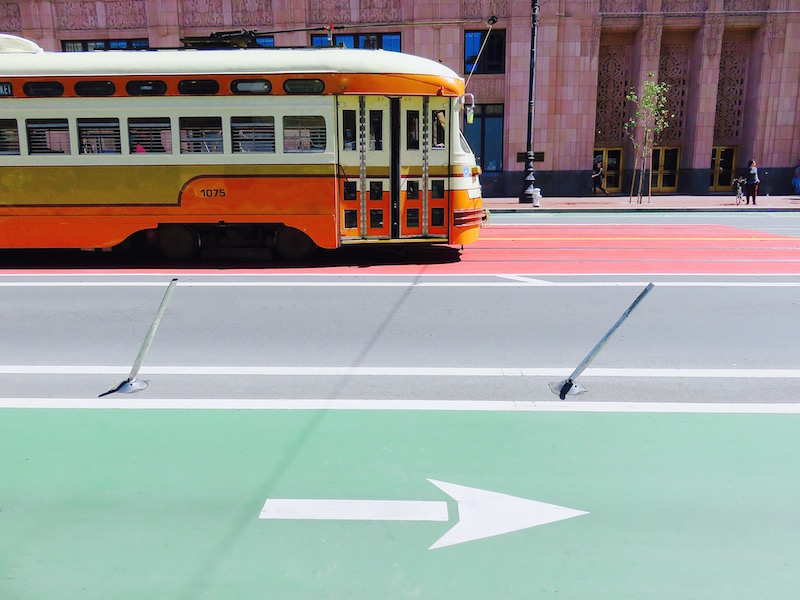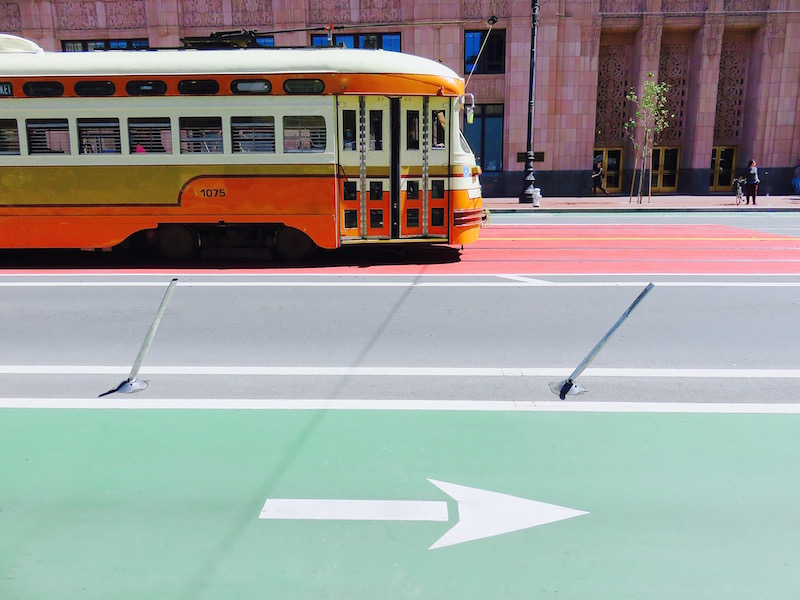Livable cities are made up of ten-minute neighborhoods, where residents can access many of the needs of daily life within a short walk or cycle trip home – diverse housing, a grocery store, places to eat and drink, shops and services, quality transit, parks and playgrounds, libraries and recreation centers, schools and clinics.
Not all our daily needs can be within a short walk from home, so a livable city is also a 30-minute city. City dwellers should be within thirty minutes of other daily needs, including jobs, education, health care, arts and culture, and wild nature, by sustainable transportation – walking, cycling, and/or transit.
Sound good? We think so too. And a thirty-minute city of ten-minute neighborhoods is built on a foundation of good public transit. Public transit is essential to a healthy, sustainable, equitable, and livable city.

The Covid pandemic has had far-reaching effects on all our lives. It has precipitated the biggest crisis in the region’s public transit system since the mid-20th century. Decisions that governments make about public transit over the next few months will have profound consequences for both our near-term mobility and the region’s long-term livability, including whether we progress towards equity and sustainability, or slide further back. San Francisco’s plan to address climate change centers on getting to 80% of trips by sustainable transportation modes by 2030, from about 50% of trips immediately pre-covid.
Since quarantine began in March, ridership on BART has declined about 90% from the same time last year. Caltrain’s ridership also dropped by an even higher percentage. Muni’s ridership has declined by 14% since March.
Over 60% of BART’s and Caltrain’s operating budgets come from fares, so the ridership downturn has endangered both agencies’ ability to operate. Both agencies curtailed their service frequency and hours. Muni fares account for between 20 and 25% of the agency’s operating budget, so although it did not suffer as large an operating loss as BART and Caltrain, it slashed service in order to ensure worker and rider safety, reducing the number of routes from 79 pre-Covid to just 17 at the beginning of April. Muni has been gradually adding service back since then, but is still offering far less service than in March. Light rail service resumed for only a few days before it was closed again, when serious defects in its overhead wires were revealed.
For many of us, quarantine has either meant working from home, or meant we lost work. Some of us still need to travel to work every day. These essential workers – the people who provide us with health care, food, critical goods and services, and keep the complicated infrastructure of our civilization clean and in good repair – rely heavily on public transit. Their difficult and sometimes dangerous jobs have become harder as transit options have shrunk. People who rely on transit to access essential services, like groceries or health care, have also seen their mobility diminished. Many of us aren’t taking transit because the transit we depended on has disappeared. Some of us have abandoned transit because we perceive it as particularly risky – a perception that is mostly unwarranted.
Prior to the pandemic, our transit system was struggling to cope with booming ridership, increasing traffic congestion, and decades of under-investment in essential infrastructure and services. In recent years transit agencies did get started on some major essential projects. BART is replacing and expanding its fleet of railcars, and modernizing and earthquake-retrofitting its aging infrastructure. Caltrain is finally electrifying the railway, and also replacing and expanding its entire fleet with modern electric train sets. The Transbay Transit Center’s bus terminal is completed, and the future rail station is awaiting its downtown connection. Muni has been replacing its buses and light rail cars, and building the Central Subway to connect SoMa and Chinatown.
These big investments promise to deliver a safer, more reliable, greener, more resilient, and less crowded transit future for the region. One of the few positive outcomes of quarantine is that the reduced transit service has allowed some transit retrofit work to accelerate.
To get to a future where transit can support a greener and more equitable region, we need to act urgently to save transit. Our already wobbly system of funding transit is in deep trouble. Without an influx of funding we’ll see more savage cuts to transit service. We may even see Caltrain shut down altogether even as it completes billions of dollars in system upgrades. Most of the infrastructure improvements now underway will continue, but we need to plan, fund, and build the next set of transit investments. We need to make sure our enormous transit investments are maximizing benefit to the region by getting smarter about coordination, access, and land use. Here are our six strategies for getting from here to there.
- Stabilize transit funding. We need to fund essential public transit services. City, regional, state, and federal governments must fund transit service, and close gaps in transit service provide mobility for essential workers and essential trips. Measure RR on the November ballot is a critical piece. Over the longer term, we need to reform how we fund transit to keep both transit service and essential investments in system maintenance, repair, and replacement stable through economic cycles, and make service more affordable for all.
- Coordinate fares and services. The region’s transit fares, schedules, and connections have been poorly coordinated for too long, creating unnecessary hardships for most transit riders and excluding others. As transit service has been disrupted and reduced, those disconnects become more of a burden and impediment to mobility.
- Improve transit speed and reliability. Transit service is many San Francisco neighborhoods is slow and unreliable. Sometimes that’s due to ageing or inadequate infrastructure, or shortages of personnel like drivers and mechanics. Much of it is due to delays from auto traffic; every Muni line operates mixed in traffic for at least part of its route. The quickest and cheapest way to improve transit speed and reliability to create more dedicated transit lanes, along with other transit-priority measures like prioritizing transit at traffic signals. Where San Francisco has prioritized transit speed and reliability on City streets, like the 5-Fulton rapid improvements, the improved service has attract significant increases in ridership at a low capital and operating cost. SFMTA is moving quickly to establish more transit priority lanes while there’s a lull in auto traffic, and we support these immediate steps. We need to put more resources towards faster and more reliable street transit in upcoming City, regional, and state budgets, while also planning and funding the next big investments in regional rapid transit.
- Expand access. The region has invested billions to expand and improve transit, but we too often skimp on access. We’ll spent hundreds of millions of dollars per mile to extend BART, but then neglect to provide sidewalks and bike lanes to get people to the new stations. Every regional transit station should have safe, direct, and convenient walking and cycling access in all directions. Most, including most of San Francisco’s BART and Caltrain stations, are deficient. Every Muni stop ought to be fully accessible, which means extending curbs and building boarding islands, and transitioning to low-floor vehicles for street-running transit.
- Expand the region’s frequent transit network. Service on many lines in the region is frequent only during commute hours, with infrequent service midday, evenings, and weekends. Late-night service is limited mostly to San Francisco and a few East Bay bus lines. Transit that only runs well during the commute, and then only to a few central office districts, doesn’t address the needs of car-free households and many essential workers.
- Focus on centers, not corridors. Successful rapid transit lines and stations link walkable centers to one another. A ten-minute walk is rarely more than half a mile. A bicycle can extend the ten-minute radius out to two miles, perhaps a little more. Research shows that most people are willing to walk or cycle further on the home end of a trip than on the work end. Conventional transportation planning in the Bay Area frequently takes a corridor approach which ignores all this. Corridor planning typically defines a corridor a few miles wide and a several miles long, and a high-capacity transit line is planned for the corridor, often in the median of a freeway. Plans claiming to be ‘multimodal’ might add a few segments of bike lane or cycle path, along with a few pedestrian safety improvements. Housing, office, retail, and instutional developments are encouraged to land anywhere in the corridor. Corridor planning has the separate elements that make up a walkable and bikeable city, but they aren’t in the right proximity or relation to one another. Corridor plans have mostly failed to make good neighborhoods for living and working, and seldom make truly walkable and bikeable places. Our planning needs to focus on creating walkable centers, and connect them with corridors. Major regional destinations like office centers and universities should be clustered close to frequent transit. Transit stations stranded in freeway medians are unlikely to grow into walkable and livable places. We should do our best to connect the freeway median transit we have already built to adjacent communities, but avoid building new ones – let’s instead choose routes and station locations that connect centers to one another.
We’re working on an action plan that expands on these six strategies, sustaining transit service through the duration of the Covid crisis and getting us to our goal of 80% sustainable trips within the next decade.




